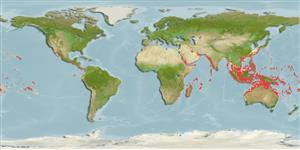Malacostraca |
Decapoda |
Xanthidae
Environment: milieu / climate zone / تغييرات عمق / distribution range
بوم شناسي
وابسته به آب سنگ; تغييرات عمق 0 - 95 m (مرجع 96667). Tropical
Indo-Pacific: South Africa to Hawaii.
Length at first maturity / Size / Weight / سن
بلوغ: Lm ? range ? - ? cm Max length : 8.0 cm CW جنس نر / بدون خواص جنسي; (مرجع 343)
Carapace distinctly broader than long, surfaces very smooth; anterolateral margin with 5 lobiform teeth (first 2 teeth never spine-tipped). Chelae very long in adults, reaching or almost reaching maximum width of carapace. Color: quite variable, from dark grey to reddish brown, often with a patchwork of grey and dark brown. One of the most distinctive memebers of the genus because of its very broad and smooth carapace with lobiform anterolateral margins, and the elongate chelipeds.
Occurs from the intertidal zone to a depth of about 20 m (Ref. 343). Subtidal on rocky areas (Ref. 801). Inhabits reefs especially on disturbed reef flats (Ref. 343) or in areas exposed to currents (Ref. 801). Found between crevices or under rock fragments (Ref. 132434).
Life cycle and mating behavior
بلوغ | تولید مثل | تخم ریزی | Eggs | Fecundity | Larvae
Members of the order Decapoda are mostly gonochoric. Mating behavior: Precopulatory courtship ritual is common (through olfactory and tactile cues); usually indirect sperm transfer.
مآخذ اصلی
مراجع | هماهنگ كننده | همكاران
Ng, P.K.L. 1998 Crabs. p. 1045-1155. In K.E. Carpenter and V.H. Niem (eds) FAO species identification guide for fishery purposes. The living marine resources of the Western Central Pacific. Volume 2. Cephalopods, crustaceans, holothurians and sharks. Rome, FAO. 1998. pp. 687-1396. (مرجع 343)
وضعيت در فهرست قرمز IUCN
(مرجع 130435: Version 2025-1)
وضعيت از نظر سايتس (مرجع 108899)
Not Evaluated
Not Evaluated
خطر برای انسان ها
استفاده انسانی
| FishSource |
ابزارها
اطلاعات بيشتر
Trophic EcologyFood items (preys)
تركيب غذايي
مصرف غذايي
شکارچیان
Population dynamicsرشد
Max. ages / sizes
Length-weight rel.
Length-length rel.
نوسانات طولی
Mass conversion
فراواني
Life cycleتولید مثلبلوغFecundityتخم ریزیEggsنمو تخمLarvae PhysiologyOxygen consumption
Human RelatedStamps, coins, misc.
منابع اينترنتي
Estimates based on models
Preferred temperature
(Ref.
115969): 24.5 - 29.1, mean 28 (based on 1756 cells).
Fishing Vulnerability
Low vulnerability (10 of 100).
طبقه قيمت
Unknown.
